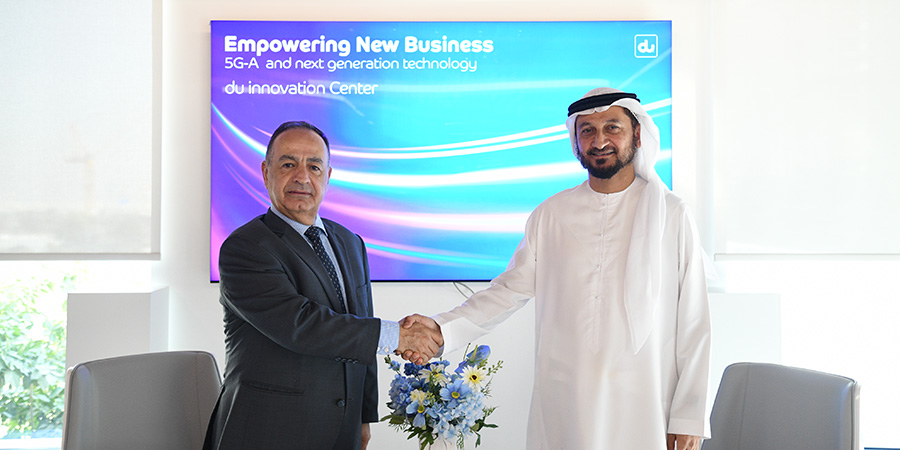The United Arab Emirates (UAE) is at the forefront of innovation and global digital transformation, delivering next-generation digital services to enterprises and consumers. du, one of the country’s leading telecom and digital service providers, has demonstrated its commitment to advancing the 5G Advanced innovation and UAE’s digital landscape.
Toni Eid, CEO of Trace Media International, and Founder of Telecom Review Group, conducted an exclusive interview with Saleem Alblooshi, du’s Chief Technology Officer, who explored du’s strategies in adopting 5G-Advanced, the transition to 6G technology, and balancing innovation with sustainability.
Leveraging 5G-A and Launching the du Innovation Center
Alblooshi emphasized that du’s infrastructure is among the most advanced in the world, having adopted the latest technologies to enhance mobile, fiber, and fixed infrastructures. The company has harnessed technological capabilities to introduce new use cases and accelerate its fixed infrastructure rollout.
The du CTO underscored that, in 2023, the company introduced some of the best commercial infrastructure and services in a production network. The launch of 5G-Advanced (5G-A) showcased its potential use cases and diverse capabilities at du’s recently-launched, innovative 5G-A Villa.
Utilizing its advanced infrastructure, 5G-A In-Building Solutions (IBS) were implemented. “We keep up to date with the latest technologies, enabling the infrastructure and positioning the UAE as one of the fastest networks in the world. We contribute to this by maintaining that position from an infrastructure perspective,” Alblooshi accentuated.
The launch of the du Innovation Center further demonstrates du’s commitment to driving connectivity by delivering ultra-high-speed capabilities, according to Alblooshi. The company leverages its partnerships with industry players in the ecosystem by showcasing network potential to its customers, enabling productivity, efficiency, and business transformation.
Adopting 5G-A and Transitioning to 6G Technology
Regarding the adoption of 5G-A and the transition to 6G network technology, Alblooshi revealed that du prioritized 5G-A implementation in 2024 to deliver enhanced speeds.
Spectrum availability has accelerated du’s infrastructure deployment, and, as a result, the company demonstrated a 4.5 Gbps throughput on its network using 5G-A.
“2025 is the year where we accelerate the rollout of 5G-A, covering more communities and focusing on indoor coverage. Driven by businesses’ needs, we are accelerating the investment and deployment of our 5G-A network,” he added.
du is an integral part of the 6G ecosystem, contributing to the definition of its standards. Recently, the UAE-based telecom operator collaborated with the Telecommunications and Digital Government Regulatory Authority (TDRA) and industry vendors, publishing a paper on 6G expectations and standardization. The du CTO emphasized the company’s commitment to being an early adopter of 6G technology, which is expected to arrive by 2030.
Addressing Exponential Data Growth
When asked if du is ready to cater to the demand for more data, Alblooshi highlighted that du has experienced a 700% increase in mobile data traffic over the last four years.
This exponential growth, driven by 5G infrastructures, delivers ultra-fast speed, positioning the UAE as a global leader in connectivity. This reflects the commitment, engagement, and professionalism of du’s workforce in driving advancement alongside other industry players.
With the growing adoption of artificial intelligence (AI), the du CTO forecasted that there will be an increase in mobile data traffic in the coming four years, with one-third set to be generated by AI.
Alblooshi emphasized that du remains committed to scaling its infrastructure and enhancing connectivity to meet the expectations of its customers.
du Exclusive: Going Beyond the Core
Key Pillars of Strategic Focus for 2025 and Beyond
Driven by leadership in the region, the TDRA’s collaboration with operators has resulted in more investments in infrastructure, ultimately positioning the UAE as one of the countries with the fastest-growing infrastructures in the world.
Alblooshi stressed that du is prioritizing modernization to lead in infrastructure development. The company’s strategy and vision remain centered on utilizing data to connect the east and west, particularly in terms of international fiber infrastructure deployment.
This rollout will expand du’s footprint, building on its existing coverage, which already spans 99% of populated areas. The du CTO also underlined the company’s efforts in modernizing the core, packet core, and IP core networks, and optical infrastructure.
Alblooshi outlined du’s key pillars of strategic focus in 2025 and beyond, which include technology and infrastructure advancements, network quality and efficiency, improved customer experience, enhanced network deployment and infrastructure operation, sustainability, and security.
He emphasized the significance of securing data and focusing on confidentiality, integrity, and availability to aptly cater to du customers’ needs.
Balancing Innovation with Sustainability
Sustainability is a major focal point in the telecommunications industry, with companies converging at the crossroads of innovation and environmental stewardship. Driven by the exponential growth of data traffic, the demand for utility and power will significantly increase greenhouse gas (GHG) emissions.
Alblooshi underscored the value of sustainable initiatives, noting that du is well aligned with the international sustainability agenda.
Commenting on addressing sustainability concerns in the industry, Alblooshi highlighted, “The only way to control this is by driving innovation.”
The du CTO reminisced about the keynote he delivered during the recently concluded 18th edition of the Telecom Review Leaders’ Summit, where he presented an AI-based use case that can allocate network resources based on customer traffic, particularly on a specific cell. Utilizing AI, resources can be enabled or disabled automatically based on traffic resource allocation.
He highlighted du’s efforts in promoting sustainability, pointing out that there are 130 sites across the country equipped with solar panels as part of its ‘Solar on Tower’ initiative. These solar-powered towers support the energy needs of utility companies. Additionally, he emphasized the various initiatives du is pursuing to achieve its goal of reducing carbon dioxide (CO2) emissions by 2030.
More from Alblooshi:






